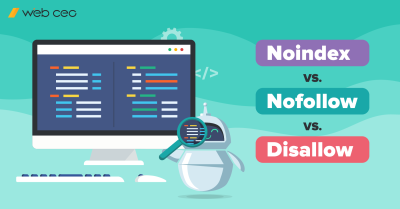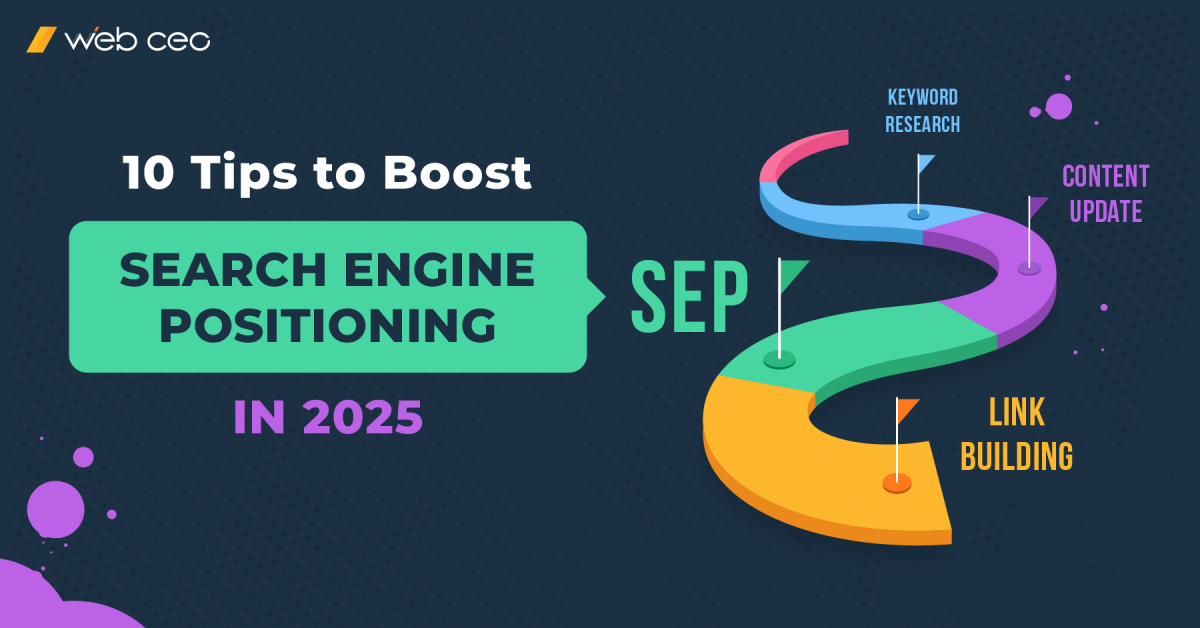
The moment you integrate SEO into your repertoire of marketing strategies, you resign your business to a never-ending war for online visibility.
Surely, you’re not the only player in your niche engaged in SEO. With over 4.7 million startups sprouting each year, the search competition is bound to get more heated.
If your web pages still don’t appear on Google’s first page after years of optimization, it’s time to recalibrate your search engine positioning strategies.
What is Search Engine Positioning?
Search engine positioning (SEP) is the strategic process of optimizing web pages to achieve higher rankings in search engine results for targeted keywords.
Sound familiar?
Yes. SEO and SEP are closely related.
Search engine positioning is a subset of search engine optimization.
The only difference is that SEO focuses on optimizing the entire website using a broad range of strategies, while SEP concentrates on improving the SERP performance of targeted keywords or specific web pages.
Why Does Search Engine Positioning Matter?
Employing SEO strategies gives your site a massive boost in overall performance on search results. However, even with sitewide optimization, some web pages will perform inferiorly to other pages on a well-optimized website.
That’s where search engine positioning comes in.
Below is a further breakdown of how search engine positioning can benefit your business:
- Visibility and Traffic
According to Backlinko, the top 1-3 results on Google have a CTR of 31.73%, 24.71%, and 18.66%, respectively. This trend decreases exponentially as you go down the SERP rankings.
Better SEP means your inferior pages become competitive enough to appear at the top of SERPs for given search queries. This increases the chances of potential customers finding you, clicking your link, and driving more organic traffic to your website.
- Credibility and Trust
Ranking well on search engines is indicative of your credibility and trustworthiness.
Remember that Google uses ranking signals like backlinks, which are viewed as votes of confidence. There is also a massive correlation between the quantity and quality of backlinks to a page’s SERP ranking.
In other words, snagging Google’s top spot adds a layer of authority to your brand. Plus, people associate high rank with having reliable information and top-notch services.
- Cost-effective Marketing
SEP leverages the power of organic traffic, which is free compared to paid advertising or other marketing tactics. By optimizing your website, you can attract potential customers without constantly spending on ads.
Improve Search Engine Positioning with These 10 Tips
So, how exactly do you employ search engine positioning on your website?
Check these tips out!
1. Audit Site Regularly
Site audits are the cornerstone of any search engine positioning strategy.
This process identifies technical issues that can hinder web crawlers from discovering or indexing your pages, such as loading time, mobile optimization, or security vulnerabilities.
Site audits also uncover areas where your content might be lacking, such as keyword relevance, informational depth, or search intent mismatch. Armed with a site auditing tool, these on-page optimization opportunities are easy to spot.
WebCEO offers a comprehensive tool for analyzing your website, giving you a bird’s eye view of the necessary information to elevate your SEP. This includes SEO score, average ranking position, traffic, and technical errors, among others.
Its intelligent on-page SEO check gives you a detailed audit of any page you’re optimizing. Learn more about WebCEO’s site audit tool here.
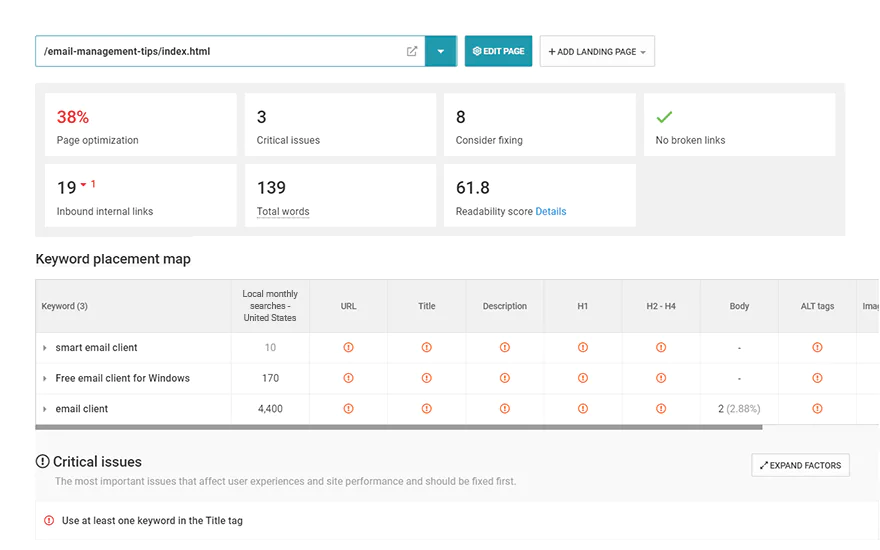
2. Conduct Comprehensive Keyword Research and Targeting
Imagine venturing into a vast forest without a map or compass. Keyword research plays a similar role in search engine positioning.
Web pages need content to be relevant. On the other hand, content needs keywords and effective targeting to be visible.
Keyword research helps you identify the terms and phrases your audience types into search engines to find information on your products, services, or industry. By ranking for these keywords, you ensure your content directly addresses your audience’s needs.
WebCEO’s keyword research tool is a wonderful starting point for keyword research. Just key in your term to find the best high-volume, low-difficulty keywords relevant to your business.
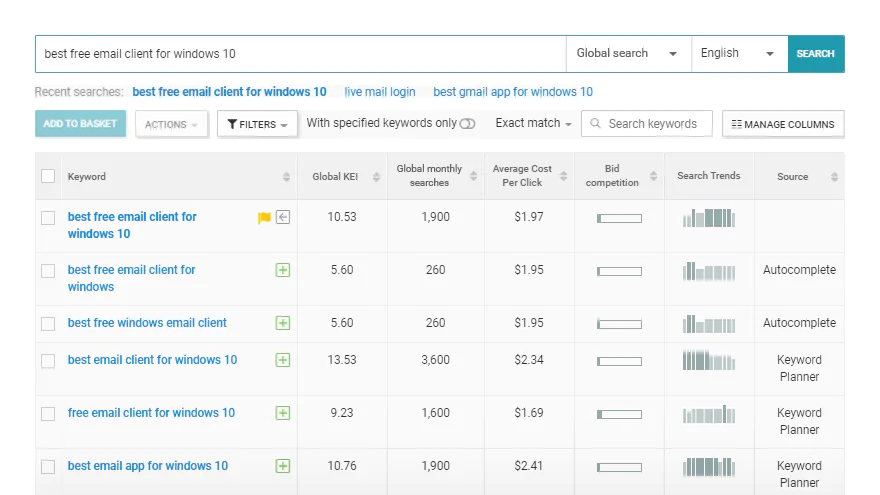
Users can also arrange the results using each keyword metric. The tool also reveals under-the-radar keywords, which might be helpful for niche industries.
For businesses engaged in local SEO, the Get Suggestions tab shows local keyword suggestions specific to your desired country or city.
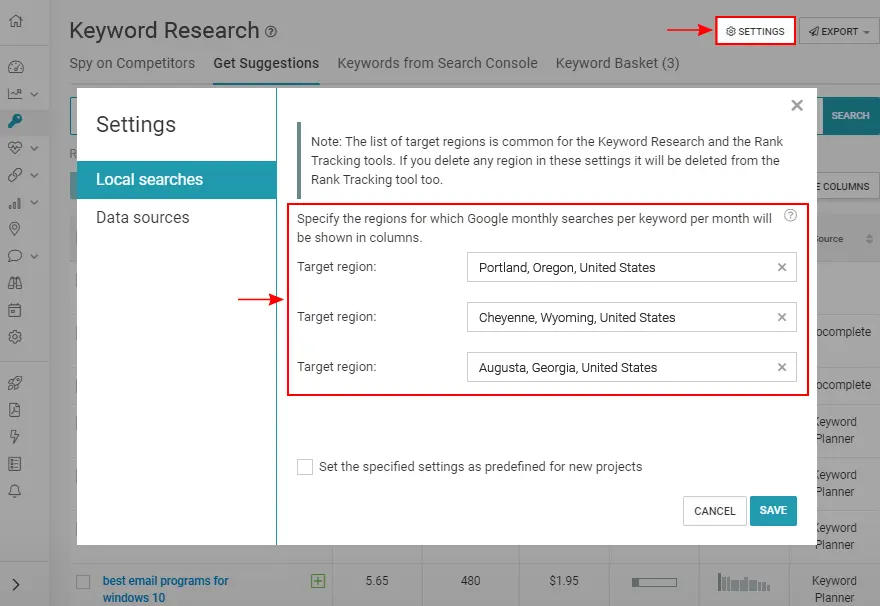
3. Write Compelling Meta Tags and Descriptions
While meta tags and descriptions have little to do with Google’s ranking algorithm, they play a significant role in a user’s clickthrough behavior.
Compelling meta titles and descriptions are likelier to get clicked than those with generic, poorly written meta tags. OptinMonster says 4 out of 10 people click on results based on the quality of meta descriptions, emphasizing the importance of well-crafted meta tags.
Here are a few tips to optimize your meta titles and descriptions:
- Include keywords: Incorporate relevant keywords that accurately represent the page’s content. This helps search engines understand the topic of your page.
- Keep it concise: Aim for a title between 50 and 60 characters long to ensure it displays properly in search results without being truncated.
- Be descriptive and compelling: Craft titles that accurately describe the page’s content while also enticing users to click through.
- Add power words: Use action-oriented language, numbers, or emotional triggers to grab attention and encourage clicks.
- Include brand name (if applicable): If your brand is well-known or if branding is essential for the page, include your brand name towards the beginning or end of the title.
4. Optimize Your Content
The adage “Content is King” holds in the realm of search engine positioning. While technical SEO is important, your content’s quality and value ultimately determine how high you rank in search results.
High-quality content heavily intertwines with user engagement. With informative, engaging, problem-solving content, you can keep visitors hooked on your page, encouraging them to return for more.
But optimized content is more than just having good prose.
It combines relevant information, search intent alignment, good keyword integration, expertise, and new insights. Only by having these qualities can your page win the race for search engine positioning.
WebCEO’s content assistant is a robust toolkit designed to elevate your content creation process and etch your page on Google’s first page. Here are three ways it can help you:
- Discover competing pages for the keyword so you can replicate their best strategies.
- Run a content analysis to unmask optimization opportunities between your content and competitors.
- Receive intelligent SEO advice to improve your content and outcompete rivals.
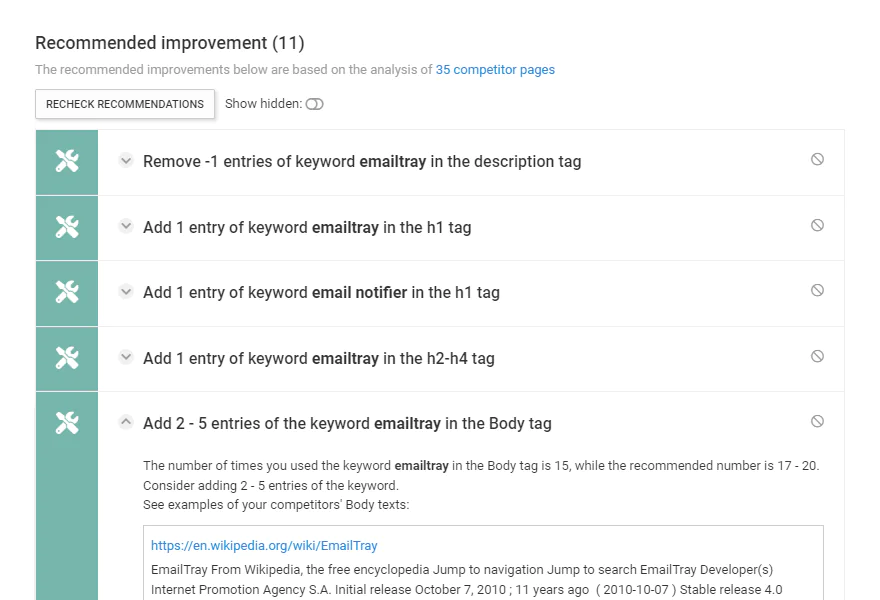
5. Keep Content Updated
Writing exceptional content is one thing; regularly optimizing it is another.
Since content will be living indefinitely on your site, they must add value to your business. Updating your content to remain competitive on SERPs does just that.
Because in the ever-evolving world of search engines, fresh content always reigns supreme. According to Search Engine Journal, content freshness is a ranking factor.
But giving content a refresh is more than just changing the publication date or updating the meta title. John Mu says doing just that disrespects your users and content.
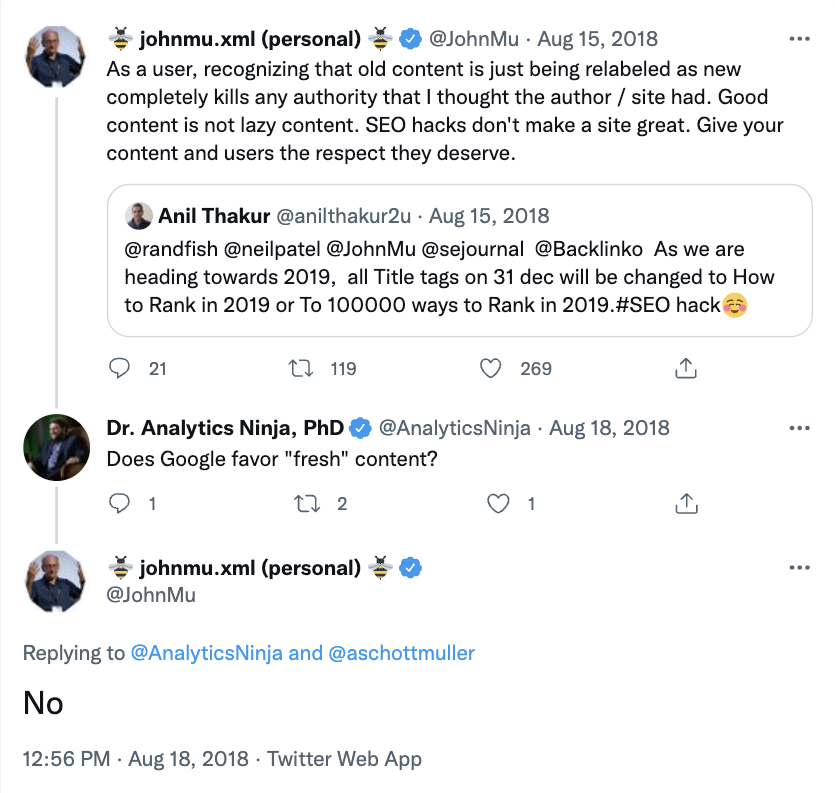
Source: Search Engine Journal
Plus, regularly updating content safeguards them from getting removed from Google’s index. Web crawlers scour the web regularly and the search engine may de-index stale content no longer relevant in today’s business landscape.
Here are smart ways to keep content fresh:
- Regularly update evergreen content: Identify evergreen pages on your website that remain relevant over time. Update these articles with new information, statistics, or examples to keep them current.
- Update outdated information: Review your existing content to ensure all information is accurate and up-to-date. Update statistics, facts, and figures as needed.
- Refresh visual content: Revamp old images, graphics, and other visual elements to keep them fresh and engaging. This could involve creating new visuals or replacing outdated ones.
- Optimize for new keywords: Conduct keyword research regularly to identify new opportunities for optimizing your content. Update existing content to incorporate relevant keywords and breathe life into its search visibility.
- Add links to related content: Update the page by adding internal links to related articles, blog posts, or resources on your website. This encourages visitors to explore more of your content and can improve the site’s internal linking structure.
- Respond to user feedback: If comments are enabled, monitor them regularly and respond promptly. Aside from keeping the page active, addressing comments also improves user satisfaction and retention.
- Analyze competitor content: Track their SEO metrics to find content that performs well, then read it carefully to get new ideas that you could use yourself.
6. Engage in Link-building
Link building, the process of acquiring links from other websites to your own, is a powerful strategy for boosting your SEP.
As mentioned above, backlinks are like votes of confidence. When reputable websites link to your target page, it essentially tells search engines, “This website is a valuable resource.” Backlinks also transfer PageRank or link juice, resulting in a boost in SERP performance.
Moreover, like all hyperlinks, backlinks are conduits for valuable referral traffic. The more high-quality backlinks, the more avenues there are for brand discovery.
While the impact of backlinks is undeniable, not all backlinks are the same.
Studies show that some backlinks decay faster than others depending on their follow attribute and the linking site’s authority. This emphasizes the importance of a backlink analysis tool to manage and maintain your page’s healthy backlink profile consciously.
WebCEO’s backlink checker showcases all the necessary metrics on backlinks, like anchor text, trust flow, citation flow, etc. The tool also lets you see your backlink profile at a glance and informs you of any changes to your backlinks.
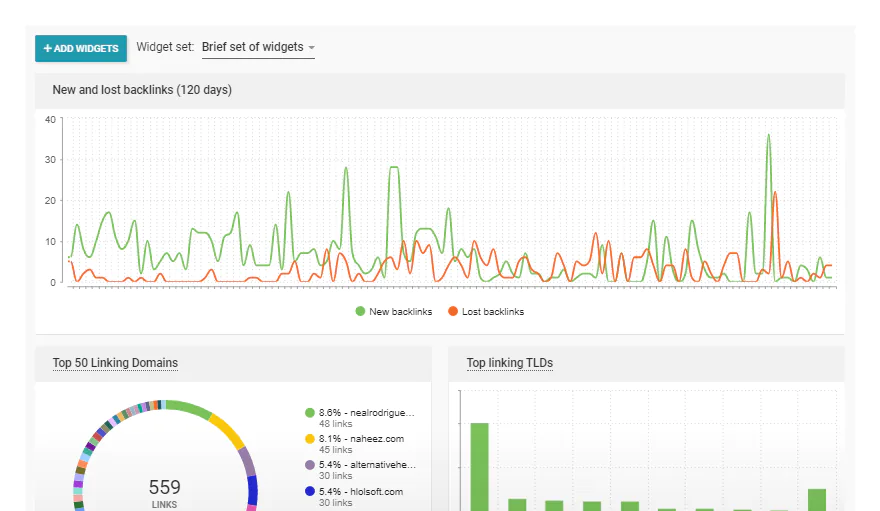
7. Build Internal Links
Backlinks are only a single facet of the link-building process. Aside from building links from external sources back to your target pages, it’s equally crucial to establish connections between each relevant page.
This is called internal linking.
Internal links go beyond boosting search engine positioning. They create a well-organized website structure that benefits even your SEO efforts.
By building internal links, users can easily navigate between relevant pages and find the information they seek efficiently. This boosts dwell time and on-site CTR, which are SEO signals.
Internal links, like backlinks, also pass PageRank from the source to the target page. Linking high-authority, high-performing pages to lower-authority ones helps improve the ranking of those less prominent pages.
WebCEO’s internal linking tool is helpful in analyzing the performance of your internal links. Users can use this tool to see their anchor text usage, analyze page authority, and even assess how much PageRank transfers from the source to the linked page.
Remember to check the tool’s “Pages Not Linking” tab. Clicking on this option reveals viable opportunities for internal linking.
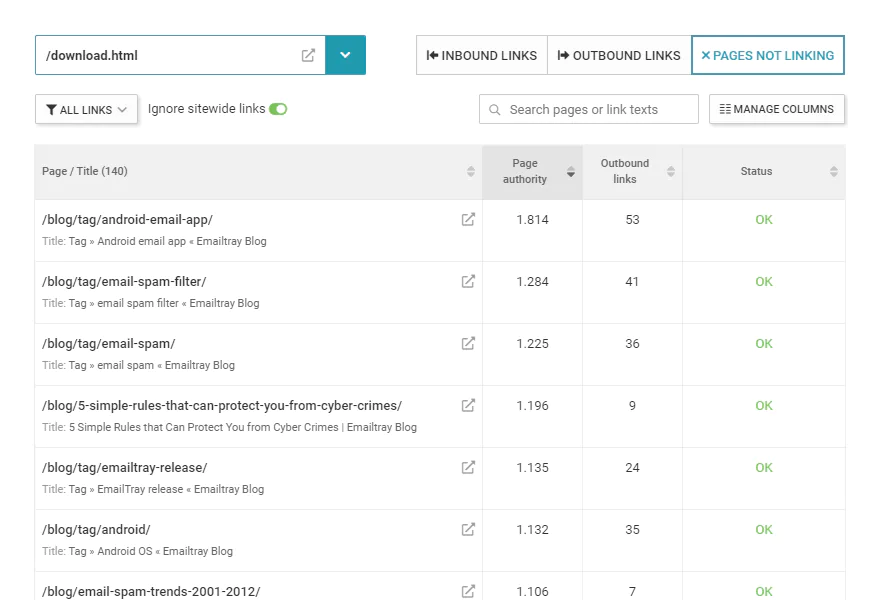
8. Establish Topical Authority
Concerning the previous tip, internal linking is not only a means for referral traffic and equity transfer. Targeted internal linking can also establish topical authority, which is crucial for improving search engine positioning.
You can achieve this using the topical cluster strategy. This is a content organization method to improve the ranking of web pages for a particular subject area.
Topical clusters are composed of two major elements:
- Pillar post: A comprehensive, long-form content that covers a broad topic in detail.
- Cluster content: Subtopic pages that branch out from that pillar page.
The pillar post becomes the central hub page, surrounded by pieces of cluster content connected using internal links.
In the end, this is how it should look like:
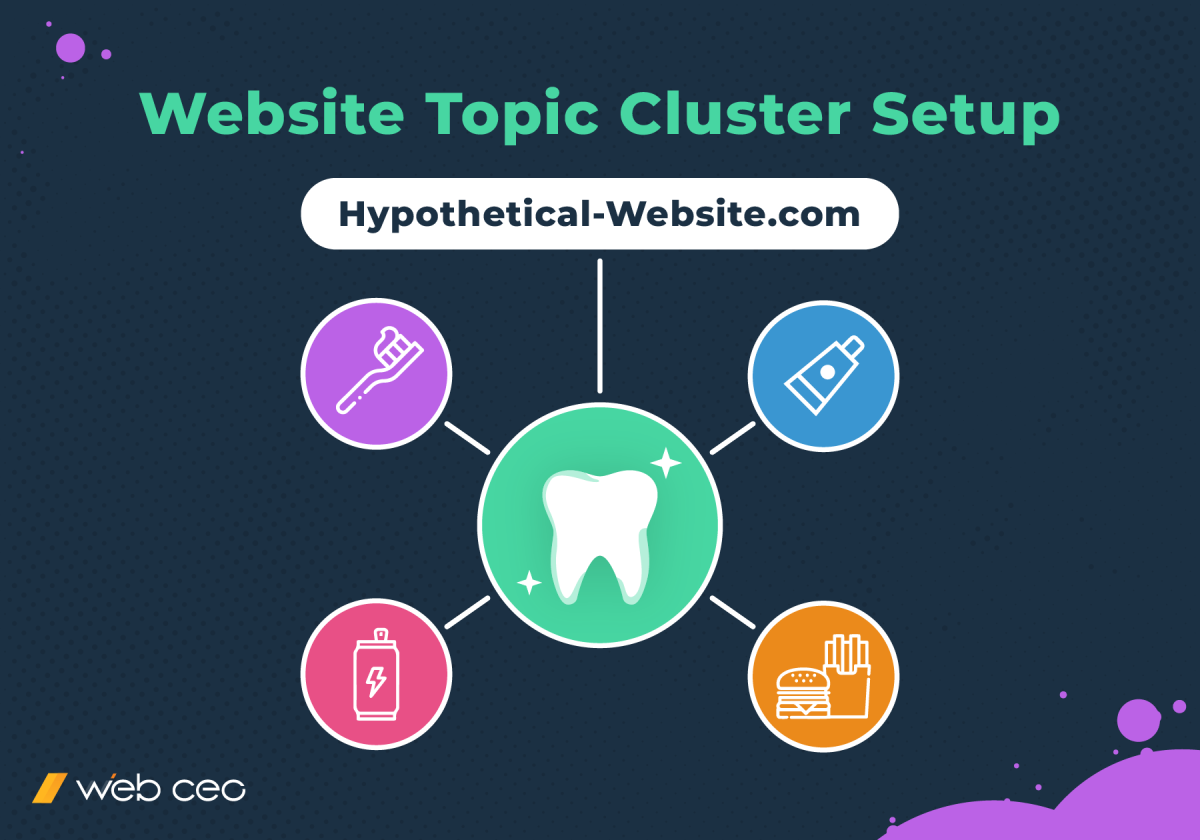
A topical cluster setup increases your site’s topical authority. By extension, each web page under those topical clusters gets a boost in SERP performance, thus benefiting your search engine positioning.
9. Speed Up Your Site
In today’s fast-paced digital world, website speed is no longer a luxury; it’s a necessity.
Page loading time is a ranking factor for both mobile and desktop searches. With Google’s focus on positive user experience, a slow web page goes against the grain.
Slow-loading pages only frustrate users, leading to high bounce rates and reduced dwell time. Conversely, a speedy site leaves a positive user experience, keeping visitors engaged and increasing conversion rates. After all, users are likelier to complete desired actions on a website that performs well.
WebCEO’s site audit tool includes a page speed test to ensure your pages give users the best possible experience. The tool also provides actionable instructions on how to fix speed-related issues it encounters on your website.
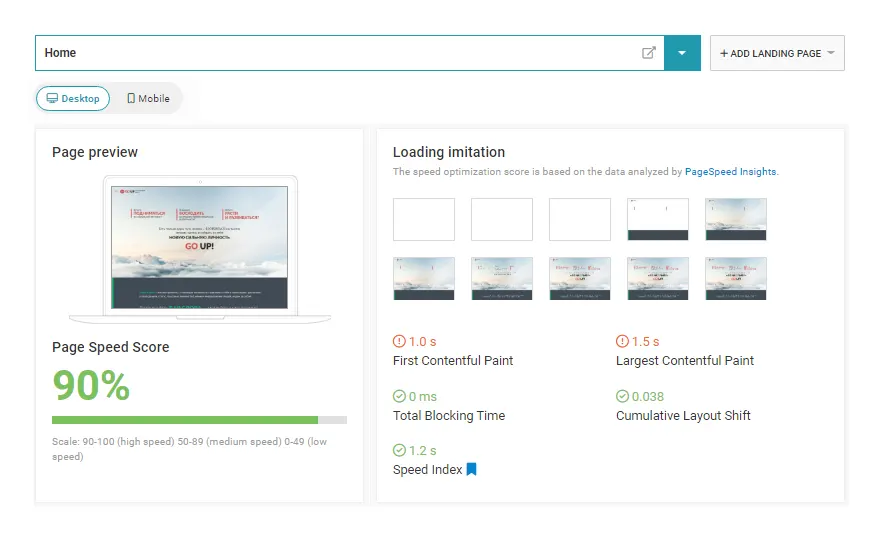
10. Optimize for SERP Features
Optimizing content for a favorable SERP ranking is good.
But landing Google’s position #1 for a given query is not the end-all, be-all of your SEP approach.
Search engine results pages are becoming increasingly sophisticated and feature-rich. They now offer users various ways to find the information they need.
Optimizing your website content for these SERP features can significantly benefit your search engine positioning strategy.
For instance, featured snippets, knowledge panels, or image packs occupy prime real estate at the top of SERPs. You gain significant visibility by optimizing your content to appear in these features. This lets you grab user attention and drive organic traffic to your website, even if you don’t hold the number one ranking.
As for local businesses, optimizing your Google Business Profile listing puts you on top of local searches. Customers from your locality are more likely to find locally operating companies that are optimized for local SEO.
Afterword
If you do SEO for your site, then you’ve already made some progress in search engine positioning. All it needs is some extra emphasis on content optimization.
If you’re aiming to get your pages to the top spot on Google SERPs, you need all the help you can get. Use online SEO tools to elevate your search engine positioning.
Check this complete breakdown of WebCEO’s online SEO tools for more information.


